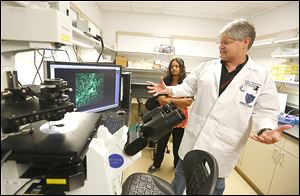
UNIVERSITY OF TOLEDO
Grant to help study of Lyme disease
Researcher looks into the bacteria
7/18/2016University of Toledo microbiologist Mark Wooten has spent his entire 21-year career studying Lyme disease and trying to solve the puzzle behind how it is activated in humans.
Considered one of the top researchers in the field, Mr. Wooten has received a new grant of nearly $2 million from the federal government. The grant from the National Institutes of Health may get him and his team a step closer to unlocking the mysteries of the Borrelia burgdorferi, the bacteria that causes Lyme disease.

University of Toledo microbiologist Mark Wooten, right, and Padmapriya Sekar, a postdoctoral fellow, look at a time-lapse of Lyme disease bacteria in a mouse at his lab.
Research of this kind is painstaking and intricate. Unlike in the movies, in which disease cures are discovered seemingly overnight, Mr. Wooten has spent years building on small discoveries in his lab.
“I’ve watched a single mouse for over two years, and so actually for the first time we see what Lyme disease looks like in an animal rather than just guessing,” he said.
He uses mice to study the disease because they are a natural host for the bacteria but it doesn’t make them sick. Once a mouse is infected, it stays infected for life, he said.
This disease is particularly tricky to study because the bacteria cannot live outside of a live host. “They only do what they do in an animal, so it makes it very hard,” Mr. Wooten said.
According to the Centers for Disease Control and Prevention, Lyme disease is transmitted to humans through the bite of an infected blacklegged tick. It can also infect dogs and horses, Mr. Wooten said.
The typical symptoms include fever, headache, fatigue, and a characteristic skin rash called erythema migrans.
“So it can look like almost anything, and that’s one of the problems. Most people get bitten by a tick and don’t know because they are tiny,” he said
If left untreated, infection can spread to joints, the heart, and the nervous system, according to the CDC.
“If you don’t get the rash or if it’s in a spot you are not looking, you feel bad for a couple days and go to the doctor. He’s not going to give you anything unless he knows its Lyme disease,” Mr. Wooten said.
Then weeks or months later all of a sudden “my heart has an arrhythmia or I’ve got sore knees and you never think of Lyme disease,” he added.
Lyme disease affects 300,000 Americans each year, 40 percent of whom end up with long-term, serious health concerns, University of Toledo officials said.
If diagnosed correctly most cases can be treated successfully with antibiotics but “if the damage is to your brain or heart, even though you clear the infection with antibiotics it may never heal,” he said.
Mr. Wooten is hoping his years of meticulous research will eventually lead to a vaccine which will eradicate the disease.
When the bacteria which causes Lyme disease enters the human body it initially activates a response from a person’s immune system, which attacks the bacteria.
After a while, “it’s like the bacteria become invisible, and even though there’s still bacteria there our immune cells just quit recognizing it and just quit going there to fight it.”
With this current five-year grant, Mr. Wooten and his team are trying to figure out what tricks the bacteria are using to evade our normal immune response, he said.
“What happens if we can keep that immune response working and working? Is that gonna be enough to control the infection?”
This is just one of the mysteries he is hoping to solve with the federal grant dollars.
Mr. Wooten was chosen to receive the NIH grant by a group of his peers that reviewed his proposal, said Sam Perdue, program officer at the National Institute of Allergy and Infectious Diseases, which is an organization under the NIH umbrella.
“We don’t really know what happens very well after a tick bites a person and we don’t have a good grasp on the early stages of infection,” Mr. Perdue said.
The technology that Mr. Wooten has in his lab at UT allows him to follow the bacteria through the animals’ systems and take our understanding of the disease a step forward, he said.
Contact Marlene Harris-Taylor at: mtaylor@theblade.com, 419-724-6091, or on Twitter @marlenetaylor48.